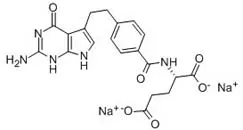| In vivo: |
| Expert Opin Investig Drugs. 2012 Apr;21(4):437-49. | | Pemetrexed disodium in ovarian cancer treatment.[Pubmed: 22324304] | Current therapies for recurrent ovarian cancer (OC) yield relatively modest improvements in survival. Many drugs are available but recently a renewed interest is addressed on antimetabolite drugs. Pemetrexed disodium (PEM) is a multitargeted antifolate cytotoxic agent mainly used in lung cancer.
METHODS AND RESULTS:
This review summarizes the available evidence on the use of Pemetrexed disodium in the treatment of OC. This article consists of material obtained via Medline, PubMed and EMBASE literature searches, up to November 2011. Currently available published data on mechanism of action, pharmacokinetics, safety and efficacy of Pemetrexed disodium in the treatment of recurrent OC are described. EXPERT OPINION: Eight trials evaluated the use of Pemetrexed disodium in OC patients. Studies using Pemetrexed disodium in combination with carboplatin in platinum-sensitive OC suggested that the response rate is similar to other combination therapies. However, based on the absence of randomized trials comparing this doublet with currently used combination treatments, it is difficult to draw conclusions on the efficacy of Pemetrexed disodium regimens in these patients.
CONCLUSIONS:
In platinum-resistant OC patients, two studies suggested that Pemetrexed disodium alone might have equivalent activity to other single-agent treatment. Further pharmacogenomic and clinical data are warranted to better define the role of Pemetrexed disodium in the treatment of recurrent OC. | | Lung Cancer. 2015 Jun;88(3):319-24. | | Predictive role of erythrocyte macrocytosis during treatment with pemetrexed in advanced non-small cell lung cancer patients.[Pubmed: 25870156 ] | Pemetrexed disodium has been approved for the treatment of advanced non-small cell lung cancer (NSCLC) non-squamous histology, both as first- and second-line therapy. Pemetrexed disodium is an antimetabolite drug, that inhibits enzymes involved in nucleotides bio-synthesis arresting cancer cells cycle. The aim of this study was the evaluation of the impact of Pemetrexed disodium on erythrocyte mean corpuscular volume (MCV) change and its possible correlation with disease control rate (DCR), progression free (PFS) and overall survival (OS) in NSCLC patients.
METHODS AND RESULTS:
A retrospective collection of clinical and laboratory data (including basal MCV and maximum MCV occurred during therapy) in advanced NSCLC patients treated with Pemetrexed disodium at seven Italian centers was performed. Nonparametric tests, univariate and multivariate analysis were used to assess correlation between variables and to identify predictors of outcomes. 191 patients were enrolled: median age 62, 60% male, 61% performance status (PS) 0, 91% stage IV, 88% adenocarcinoma histotype, 25% never smoker, 62% received Pemetrexed disodium as first-line. Mean MCV significantly increased from basal (89fL) to during treatment (94fL), with mean ΔMCV=4fL. The median time from therapy start to maximum MCV was 2.2 months. Median PFS was 7 [CI95% 6-8] and 3 [CI95% 2-4] months [P=0.0016], and median survival was 17 [CI95% 12-23] and 10 [CI95% 8-12] months [P=0.02], in patients with ΔMCV>5fL (n=80) and ΔMCV≤5fL (n=111), respectively. Multivariate analysis identified age ≥62, PS 0, adenocarcinoma histology and ΔMCV>5fL as independent predictors of longer PFS. A ΔMCV>5fL significantly correlates with DCR.
CONCLUSIONS:
Pemetrexed disodium induces macrocytosis. ΔMCV>5fL on Pemetrexed disodium therapy correlated with better DCR, PFS and OS. These results deserve further validation in prospective studies. |
|






 Cell. 2018 Jan 11;172(1-2):249-261.e12. doi: 10.1016/j.cell.2017.12.019.IF=36.216(2019)
Cell. 2018 Jan 11;172(1-2):249-261.e12. doi: 10.1016/j.cell.2017.12.019.IF=36.216(2019) Cell Metab. 2020 Mar 3;31(3):534-548.e5. doi: 10.1016/j.cmet.2020.01.002.IF=22.415(2019)
Cell Metab. 2020 Mar 3;31(3):534-548.e5. doi: 10.1016/j.cmet.2020.01.002.IF=22.415(2019) Mol Cell. 2017 Nov 16;68(4):673-685.e6. doi: 10.1016/j.molcel.2017.10.022.IF=14.548(2019)
Mol Cell. 2017 Nov 16;68(4):673-685.e6. doi: 10.1016/j.molcel.2017.10.022.IF=14.548(2019)